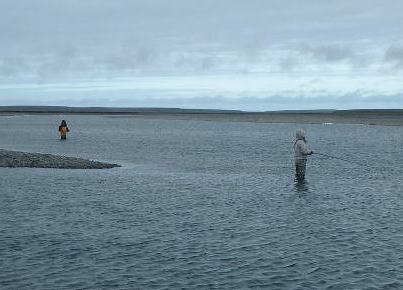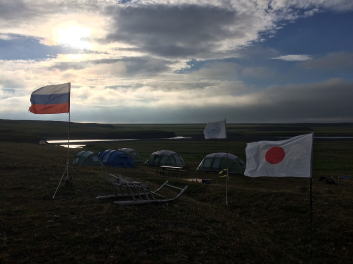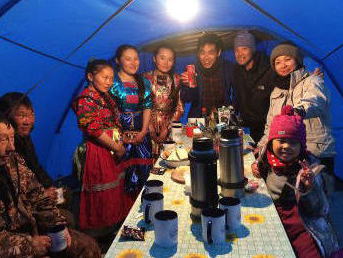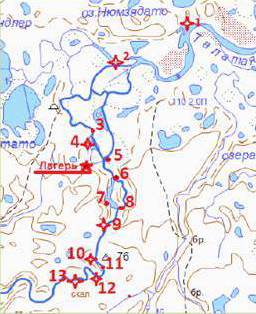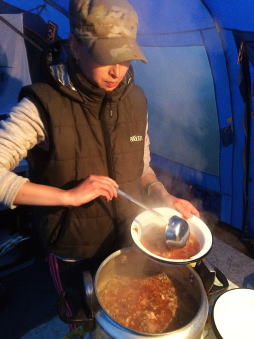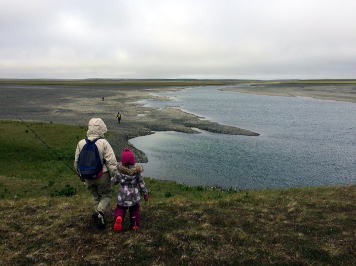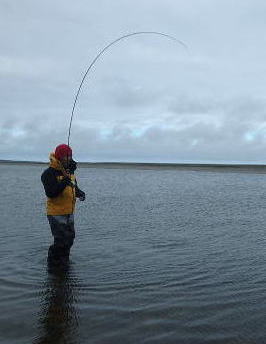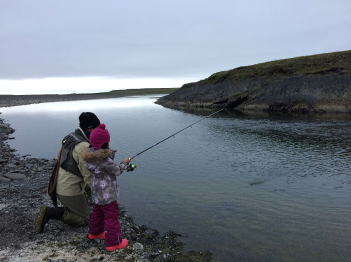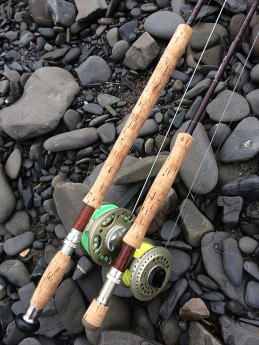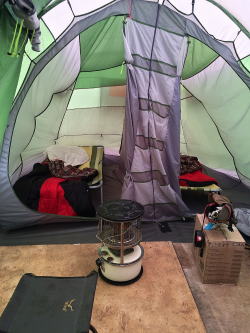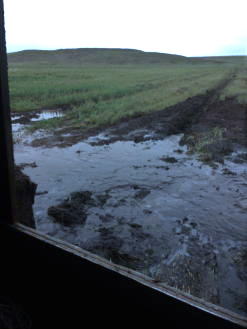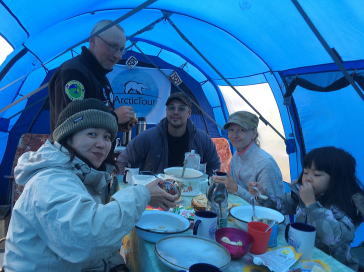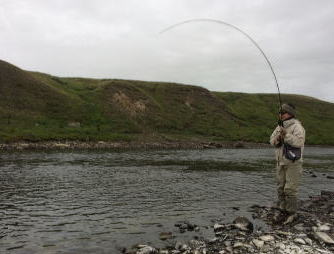Some more greylings came to welcome us but, as the wind picked up, fishing
was not that easy in such big open space.
Despite the damp chill we soundly slept.
Here it is, the base camp set up by ArcticTour on the bank of the river, Talatoyaha.
Well, no need of rush from Day1 I repeated to myself.
We headed back to the camp and heartily enjoyed the dinner Nastcha prepared
for us. Very tasty - no lip service here. I mean it!
Graylings were plentiful and all in good size. They had somewhat roundish
nose compared with the ones in Europe. These are Asian Greylings - explained
Andrey - as we are now standing on the northern slope of Ural mountains
which separates Asia and Europe. This is the western limit of Asian graylings,
and they are strong!
Indeed they were very powerful. Remarkably so compared with the ones we
know in Austria. Though 8wt rod was obviously an overkill, we still could
enjoy the fight thanks to their remarkable torque & stamina.
The wind dropped late in the evening, and many rise rings were visible
along the current line. I tried to let Misa catch one, but hmmm, , , with
a lure they were nowhere near as easy.
A family of Nenets reindeer herder visited us - no, not an everyday event
to see Japanese up here. The boys were shy but the girls were not. We had
a jolly evening me mostly drinking, with the noise of the generator as
BGM.
- Next
The camp is located some 15kms up from the sea. And we are to fish some
5kms each on the both sides of the camp.
No need to rush from Day 1. We walked down to the nearest 'home pool' to
warm up ourselves.
Talata river runs from south to north, and our camp site, indicated by
the star mark, stands about half way of the fishable length. The home pool,
#3, is a known good spot so is the pool #2 further down. But the area is
totally flat and difficult to fish when windy. The point #1 is like a estuary
and the water is salty. A good place, but this is a popular dining table
for the polar bears also, therefore we better stay away.
On the other side, upstream from the camp, the topography changes with
more hills and cliffs, which often works as a shelter against the prevailing
north westerly wind.
Thus we waited for 8 long hours and just when I was about to suggest we
postpone our departure, sure enough, done. Fixed. Alright, let's go then.
Once leaving the village, it was all wild tundra - wet and cold. Muddy
swamps everywhere but they are no hindrance for the hardyteam of Red army.
Sitting in the cabin, which in fact was a luggage space with make shift
wood deck to sit on, we listened to the clattering tunes of the caterpillars.
4 hours drive was not exactly fun. But we duly arrived at the camp at 2am,
and dropped dead.
So we walked up to the point #6-8 seeking shelter from the wind. And sure
enough, the place was much calmer and, thanks to the narrower width, it
was more like a river than a lake.
Soon we realized the river was not running much. In a big pool as this,
the water was almost staying still.
The river indeed runs faster earlier in the season, or even at this time in the middle of August in normal years. Just this time as we visited, the river was running low, some 50cms lower than normal, explained Andrey.
Well, we need to adjust our plan accordingly. We began casting and retrieving
as we do in lakes. Shortly afterward Hama had a first take - it was an
Arctic Greyling - a welcome by catch.
We were supported by a team of 3 - Andrey the main guide, Dima the sub
guide, and Nastcha the cook.
This week we were the only guests and could enjoy their hospitality all
to ourselves. Starting with a tasty hot porridge Nastcha prepared, waking
up ahead of us despite the severe chill!.
 Arctic Aug '18 - 2
Arctic Aug '18 - 2We then set on to rigging up the tackle. I came along with two rods - a
7wt, 12.6ft light doubler & a 8wt 9.0ft single. Alltmore, by Daiwa
UK.
Our main target was Arctic char, around 2-3kg / 60cm in length. Size wise
a 6wt rod could do, but the place I was warned being very windy, and we
must cast a fair distance at times. So I made the tackle choice up a little
bit.
Due to the extreme climate they operate for 2 months only - from mid June
to end August - in usual years. The camp has 3 big tents to accommodate
maximum 8-9 guests at a time.
Contrary to our worries, the tents are very well equipped - wood deck,
spring bed and, very importantly, a stove. Considering the wild wild location,
this indeed is a comfy living.
